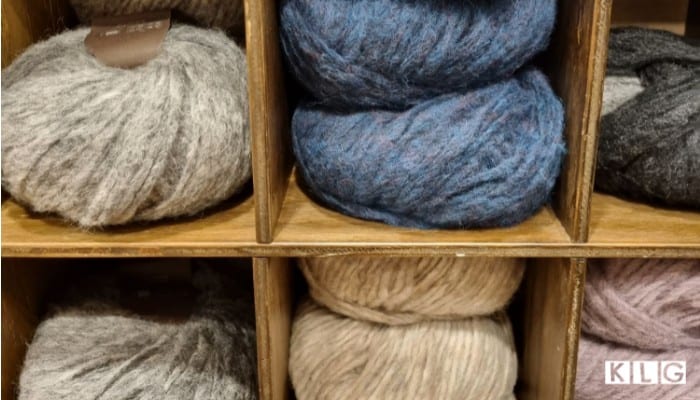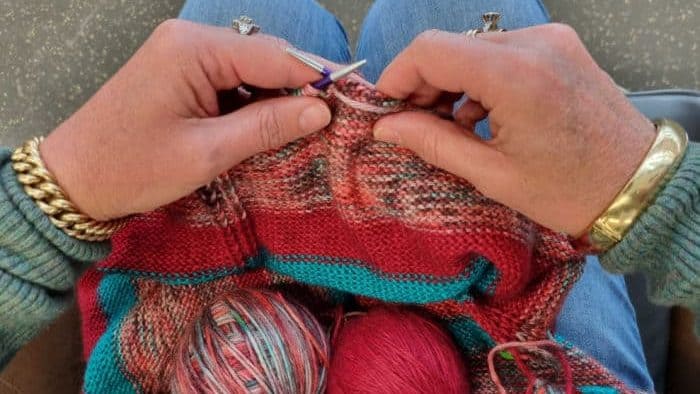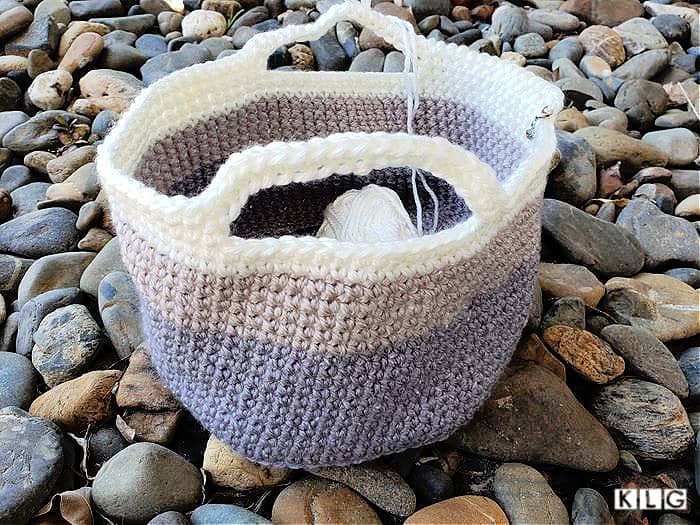Is knitting the superior yarn craft? Or crochet? What if they’re two fabulous yet unique crafts? Here’s a comparison of crochet vs knitting.

I reviewed and updated this post on Jan 2, 2024.
Table Of Contents
- What Is The Difference?
- Similarities
- Which Suits You Best?
- Knitting Vs Crocheting – Pros & Cons
- FAQS
What Is The Difference Between Knitting And Crochet?
How You Do The Craft
The main difference between knitting and crocheting.
- Knitting is done with two knitting needles
- Make a series of loops held on one of the knitting needles
- Like rings holding up a shower curtain

Knit each, moving to the next knitting needle to make a row.
There are two basic stitches.
- Purl stitch
- Knit stitch/stockinette stitch.
The latter looks like small Vs.
Purl stitches are more challenging to learn than knit stitches, so attempt the knit stitch first.
- To cast on, create a slip knot
- Hook it on one needle
- Half-knitting it to create another
- Hooking it to the needle
- Repeat
- Keep your tension even
Crochet is done with a crochet hook and is worked around in a circle or a rectangular fashion.

Work with one crochet stitch at a time, and they’re like knots.
The five basic stitches.
- Chain stitch
- Single crochet
- Half-double crochet
- Double crochet
- Slip stitch
Start with chain stitches or slip stitches to create different methods. There are two types of crochet.
- Single crochet
- Double crochet
Learn the former first. There are 500 crochet stitches to try!
Take crochet hooks out of the project and come back to it. Slip the crochet hook out, put a locking stitch marker around the loop, and leave the project until you’re ready to return.
The Look And Feel Of Finished Items
- Crochet produces heavier, bulkier, and lasts longer.
- Knitting creates drape, flexible, and stretchy knitted fabric, soft, and smooth textures.
Whether you make knitted or crocheted items, they’re something to cherish.
The Stitches
Most knitting is done with the knit and purl, as other stitches combine and expand upon techniques you already learned. The knit fabric will vary depending on the techniques used and the pattern followed.
Crochet has far more stitches than the other and the crocheted fabric has a myriad of different textures.
Materials And Tools Used
For knitting, you’ll need two needles; for crochet, you’ll need a crochet hook. Not your conventional hook, though. This single hook isn’t sharp and is slightly curved.
Knitting needles range from blunt to pointy.
Knitting and crocheting require yarn! Uses yarn weights, from bulky to lace yarn and sock yarn.
The most popular is a medium-weight yarn.
Knitters use crochet hooks to fix mistakes in their knitting. Also, while machines knit, no machine crochets.
Here is a list of standard supplies used in knitting and crocheting.
Knitting Supplies
- Knitting Needles (Straight needles, double pointed needles, circular needles, and interchangeable needles.)
- Yarn
- Stitch Counters
- Measuring tape
- Stitch Markers
- Yarn Needles
- Needle Stoppers
Crochet
- Crochet hooks (A beginner? Use a size H crochet hook.)
- Yarn or crochet thread
- Scissors
- Gauge Swatches
- Row/Stitch Counters
- A Yarn Needle
- Stitch Holders
What Projects They Suit
Knitting – Here are popular knitting projects ideas.
- Baby Garments
- Baby Blankets
- Beanies
- Cardigans
- Clothing
- Dishcloths
- Hand Towels
- Hats
- Potholders
- Shawls
- Wraps
- Scarves
- Scrubbies
- Shrugs
- Socks
- Sweaters
- Tote Bags
- Toys
Crochet Uses – There are many crochet projects. Good for projects needing thicker, heavier fabric.
- Afghans
- Amigurumi
- Baby Blanket
- Bags
- Purses
- Cowls
- Cozies
- Dishcloths
- Scrubbies
- Dog Sweaters
- Flowers
- Motifs
- Gloves
- Mittens
- Hats
- Home Décor
- Pouches
- Ponchos
- Scarves
- Socks
- Slippers
- Rugs
- Toys
Common Techniques
Here are the most recognizable.
Knitting
- Cables – Sweaters and cardigans
- Fair Isle Knitting – A style of knitting from Scotland, characterized by intricate, colorful stitchwork.
- Ribbing – Makes knitting stretchy, but holds its shape.
Crochet
- Circular – Cloths, potholders, rugs, and others.
- Granny Squares – Versatile
- Crochet Lace
The Similarities Between Knitting & Crochet
- They’re fiber arts
- They use yarn to create beautiful things
- Use patterns to create projects
- Written with abbreviations and terms
- Learning the skill and reading a pattern are two skills
- Practice skill sets like hand-eye coordination, memory elasticity, logic, color theory, and mathematical skills!
- Knit or crochet challenge your brain and keep it flexible
- Health benefits – mental, physical, and emotional
- Practice your patience! It takes time
- A rewarding hobby
- Create many projects
- Project size and complexity vary
- There are variants where you use your hands. (Finger knitting, arm knitting and finger crochet)
- Don’t require expensive tools to start
Which Would Suit You Best?
Knitting Is Best If
- You’re patient. Knitting takes time, dedication, and patience! The stitches are complicated, taking longer than you might expect.
- Want to be swamped in inspiration and ideas? There are so many knitting patterns and places to be inspired!
- You want to save money because you rarely buy as much yarn as for a crochet project. Plus, yarn advertised as knitting yarn is more affordable.
- You’re logical. Reading and creating knitting patterns requires math.
Crochet Is Best If
- You like quick projects
- You like working through many projects quickly
- You’re creative – often you have to change the limited crochet patterns to suit your preference
- You make mistakes lots. It’s much easier to fix them in this craft
- You don’t mind working in irregular or random ways
Knitting Vs Crocheting – Pros & Cons
Knitting
Pros
- You produce a heavier, thicker fabric. (Knitting is popular in winter and colder climates.)
- Stretchy
- Creates a better drape.
- Knitting is trendy and more well known than crochet
- Excellent for intricate or sophisticated design
- Great for colorwork. That’s why Fair Isle patterns are knitted.
- Confused strangers won’t question you!
- You don’t have to learn as many techniques and stitches to master knitting.
Cons
- Fixing mistakes is hard. The later you notice the mistakes, the more stitches you must undo to fix it!
- Not as fast as crochet, as it takes more stitches to create the same amount of bulk.
- More supplies to keep track of and learn how to use.
- Frustrating as there are many stitches to track
- It’s harder to make home accessories and decor as it isn’t as hard-wearing.
- Once knitting needles are used for your project, you can’t take them out until the project is completed.
- Not as easy to create toys
- Knitting needles more often get confiscated at airports if they’re in your carry on.
Crocheting
Pros
- Light, thinner fabric.
- Easy to fix mistakes. Pull the yarn, undoing the knots until you reach the place to fix the crocheting.
- Crochet is faster because more bulk comes with each stitch. But the actual speed depends on a variety of factors.
- You only use 1 instrument
- Create fun, geometrical shapes and sew them together to create unique patterns.
- No need to keep track of 20, 30, 50, or more stitches at once. You work 1 at a time!
Cons
- There are far less dedicated companies for crochet than knitting (WeCrochet is one great example!)
- Not suited to super intricate patterns
- Not easy to create complicated variety in colors.
- Crocheted clothing doesn’t look as good as knitting when it’s figure-hugging.
Pin Now to Save for Later

Myths Of Knitting – Busted
Knitting Uses Less Yarn Than Crochet
This idea that knitting is a slower process that takes up less yarn is not true. The project, yarn, stitches influence it.
Knitting Is Harder Than Crochet
Or the other version of the statement, crochet is harder than knitting. They both have a learning curve
The one you find easiest is the craft you learned first!
Don’t Knit Blankets!
This ‘rule’ comes from well-meaning advice.
Due to the stitches in a blanket, it takes far longer and more stitches to create a blanket in knitting than crochet.
There are gorgeous knitted blanket patterns available, but ensure you’re ready to commit the time.
Hand-Dyed Yarns Should Only Be For Knitting
Hand-dyed yarns vary in speckles of color, where the color changes or gets lighter or darker.
It turns out better in knitting but has stunning results in crochet. The color changes or variations are irregular.
Can You Put The Two Together?
It’s tough to discern between knitting and crochet when it’s in a finished project with no knowledge of how it was created.
Even experts and crafts enthusiasts alike struggle!
Techniques like Tunisian crochet and “knooking” produce crochet like knitting stitches or cables.
You still crochet, but it looks like knitting. Slip stitch crochet looks like knitting too.
A common way to combine them in knitting is to complete a project with a crocheted edge and vice versa.
Wherever you stand on the knitting vs crochet debate, melding the two is satisfying.
Your imagination only limits the possibilities.
FAQS About Knitting Vs Crochet
Is It Easier To Knit Or Crochet?
It depends. Experiment with both. If you learn the two, the possibilities become endless!
Is Knitting Harder Than Crocheting?
No! No craft is harder than the other. It’s up to you to decide which works best for you.
Whether you learn knitting or crochet, it’s rewarding.
Is It Easier To Teach A Child To Knit Or Crochet?
The easiest to teach a child is what you have the most experience in!
If you prefer, teach the child both and see which they excel at.
Which Is Older Knitting Or Crochet?
Knitting is older than crochet.
The oldest evidence of knitting comes from the 11th century BCE, with crochet coming from the 19th century.
A much older technique, often mistaken for crochet, is Nalebinding. It’s a different fiber art.
Yes, one could be faster, one could be easier to learn, but attempting to make a final answer is impossible.
Which do you prefer? If you like both, which did you learn first? Do you combine the two when doing projects?

I learned crochet first, then Tunisian, then knitting. I like them all for different purposes. I want to start combining different yarn crafts soon.
Great to hear Holly. Combining different yarn crafts sounds like a plan. Cheers Jodie
Hi I love knitting made a lot of baby clothes during lockdown, recently started making head bands which are quick and easy to make, with not much sewing up, as with the baby things I love all in ones hardly any sewing up.
I’ve had a dabble at crochet and made a flower, but I find it difficult to follow the videos and patterns. Knitting is easier to follow ca pattern. I do get lost on some knitting pattern so I Improvise.
Xx
Hi Hayley. That’s so good to hear. With crochet, I’ve found I have to keep practicing. Thanks for sharing your experiences! Cheers Jodie
I’ve been knitting for 60 years and crocheting for 48 years. I find both quite easy and do a lot of patterns for afghans that I design. What I have been unable to master is reading charts for either; yet a written pattern is so easy to do. I think if I were younger, reading charts might be easier to learn
Hi Ria. Thanks so much for sharing your long-time experiences. As you say, it takes time to master. Cheers Jodie
Hi, I first learnt to knit when I was 5. My mother taught me 59 years ago. At age 10 my grandmother taught me to crochet with thread. She also taught me to tat at age 18. I love to do both crafts and do not find one harder than the other. Both have gotten me through stressful situations. As a previous person commented, I cannot follow charts to save my soul! I learnt reading the patterns for both. I would recommend learning both! Enjoy.
Hi Debbie. I’d love to try tatting. Cheers Jodie
Thanks for you very thoughtful article evaluating each technique and applications. I have knitted and crocheted since I was 5 years old. My mother taught me. Since then I have enjoyed knitting, crocheting and added tatting, bobbin lace and spinning. The best part of handcrafts in general is that they can all reduce tension if you choose your projects
accordingly. At the same time, they can be challenging which is good too. Most gratifying from all of them, is that I have been able to share my projects with others. Lastly I have freely taught children and adults how to do these wonderful skills and the appreciation they have given me is wonderful. btw-I am 80 years old and still learning new techniques etc.
Hi Paulette. So good to hear about your journey. That’s great you’ve passed on your skills to others. Cheers Jodie 🙂
I believe that knitting and crochet can teach us much about science, as well as providing a feeling of satisfaction. Manipulating stitches across a knitted background offers us a bit of physics. Crochet teaches design, much like architecture. I read somewhere that spinning follows principles of aerodynamics, but I don’t spin or fly, so I can’t be sure. This is why I believe children should learn these crafts, if only to learn some scientific principles. There is nothing wrong with them enjoying creativity.
Hi Debra. How interesting. I also believe children benefit from learning these crafts. Cheers Jodie
Hello. What a fantastic article. Thank you.
I have always loved knitting taught to me by my Nan and Mum:) now a Grandma to 2 beautiful grandsons I have resurrected my patterns/needles.
Just finished 3rd blanket for the latest 3 week old boy. It is a shame it is no longer taught fully in schools.
I started knitting my clothes/scarves for my dolls.
Great exercise for keeping aging fingers nimble. Thank you again:)
Hi Rubina. How lovely to get back into knitting for your grandsons! Cheers Jodie
I learned to knit and crochet as a child. My mother is a master knitter, my grandmother crocheted. I love the process of knitting and the tapping of metal needles but my sweaters would always be too big or too small. Gauging is my nemesis. So only flat projects for me. Patterns seemed very complicated to read and process. Crochet is limitless. I can use a pattern or not , I don’t really have to think when I crochet. Once you master circles and squares, increase and decrease, you can do anything. I often just make it up as I go along. I can also put it down and leave it and come back later without worrying about loosing stitches. So my little magpie brain says crochet.
Hi Peri. How wonderful to make it up as you go along with your crochet projects! That’s an admirable skill. Cheers Jodie
My grandmother taught me to knit about 46 years ago; my sister taught me to crochet 43 years ago. Which one I prefer depends on what I’m making.The smoothness of knit makes it more comfortable for socks and clothing worn next to the skin. Crochet stitches can be beautiful, but they tend to be lumpy, and uncomfortable, between your shoe and your foot while you’re standing or walking. On the other hand, adding a long section of edging (for example, around the hem, up the front, around the collar, and down the other side of the front to join at the hem) is *so* much easier with crochet, and crochet allows for some creativity in designing your edging. So I love them both, along with combing, carding, and dyeing fiber and spinning it into various types of yarn. I’ve also used heavyweight yarn to make rugs. I haven’t tried weaving, but that’s only because I don’t have room for a loom!
Thanks so much, Jennifer for taking the time to share. It’s wonderful to learn about people’s perspectives. Cheers Jodie